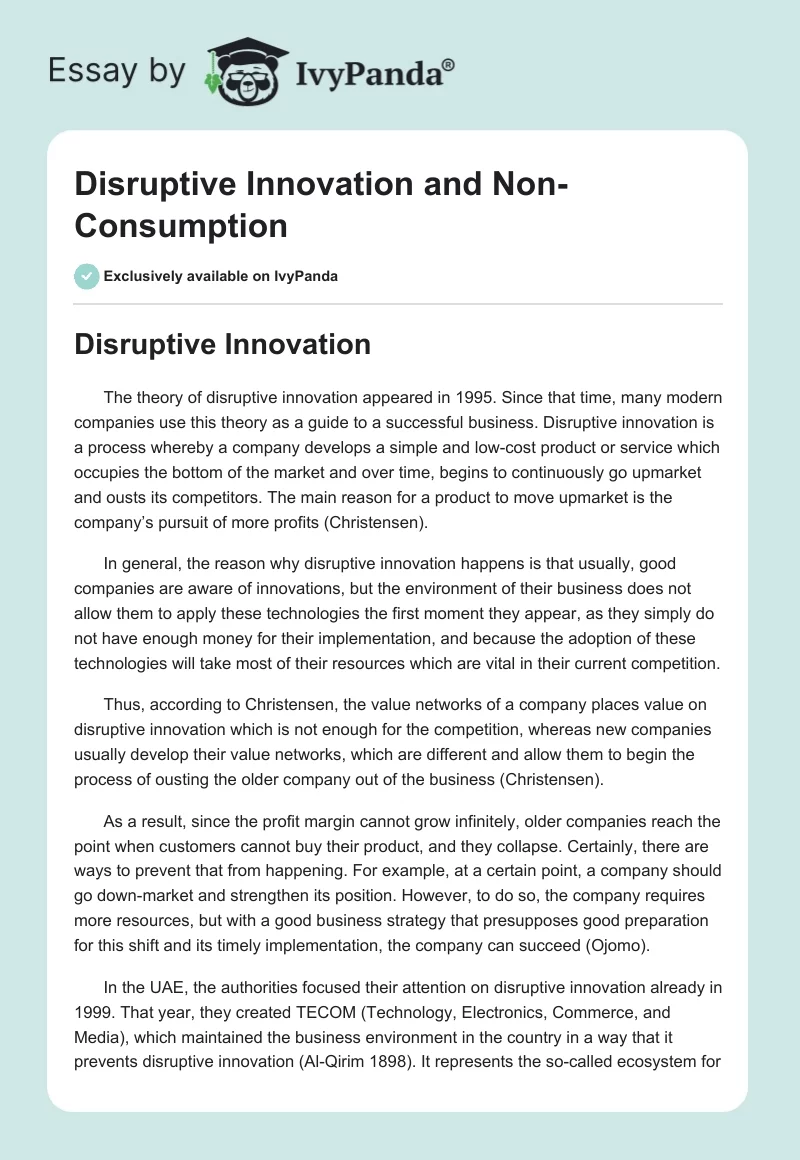Disruptive Innovation
The theory of disruptive innovation appeared in 1995. Since that time, many modern companies use this theory as a guide to a successful business. Disruptive innovation is a process whereby a company develops a simple and low-cost product or service which occupies the bottom of the market and over time, begins to continuously go upmarket and ousts its competitors. The main reason for a product to move upmarket is the company’s pursuit of more profits (Christensen).
In general, the reason why disruptive innovation happens is that usually, good companies are aware of innovations, but the environment of their business does not allow them to apply these technologies the first moment they appear, as they simply do not have enough money for their implementation, and because the adoption of these technologies will take most of their resources which are vital in their current competition.
Thus, according to Christensen, the value networks of a company places value on disruptive innovation which is not enough for the competition, whereas new companies usually develop their value networks, which are different and allow them to begin the process of ousting the older company out of the business (Christensen).
As a result, since the profit margin cannot grow infinitely, older companies reach the point when customers cannot buy their product, and they collapse. Certainly, there are ways to prevent that from happening. For example, at a certain point, a company should go down-market and strengthen its position. However, to do so, the company requires more resources, but with a good business strategy that presupposes good preparation for this shift and its timely implementation, the company can succeed (Ojomo).
In the UAE, the authorities focused their attention on disruptive innovation already in 1999. That year, they created TECOM (Technology, Electronics, Commerce, and Media), which maintained the business environment in the country in a way that it prevents disruptive innovation (Al-Qirim 1898). It represents the so-called ecosystem for innovation where there are thousands of companies in Dubai and the rest of the country which are connected and together contribute to the development of the state instead of ousting each other from the business (Kennedy 121).
Non-consumption
Non-consumption is the refusal of customers to purchase products or services primarily due to their cost. The notion of non-consumption is closely connected to the notion of disruptive innovation in a way that when the process of disruptive innovation begins, it inevitably leads to non-consumption which is the main reason for the ousted company to go bankrupt (Ojomo).
In Christensen’s opinion, managers, investors, entrepreneurs can compete against non-consumption by investing in a certain kind of innovation which is called market-creating innovation. This type of innovation allows transforming expensive and complex products into cheaper and simpler ones, thereby making them accessible to a much greater number of people. Thus, market-creating innovations eliminate non-consumption and lead to consumption.
Companies that use this type of innovation are regarded as “drivers” for economic growth. Certainly, applying this type of innovation requires additional resources, but if a company prepares for this shift beforehand, it usually succeeds (Xiao 1753).
As for the UAE, since the problem of disruptive innovation is under thorough control, the risk of non-consumption reduces to a minimum. In general, the principle of market-creating innovations dominates business in the UAE. Additionally, the problem of non-consumption is not common in the country, as they use a more collaborative approach in doing business rather than competitive (Stall).
Works Cited
Al-Qirim, Nabeel. “An Empirical Investigation of Smart Board Innovations in Teaching in UAE University.” Education and Information Technologies, vol. 21, no. 6, 2016, pp. 1895-1911.
Christensen, Clayton M. et al. “What Is Disruptive Innovation?” Harvard Business Review. 2015. Web.
Kennedy, William R. et al. Dubai – The Epicenter of Modern Innovation: A Guide to Implementing Innovation Strategies. CRC Press, 2017.
Ojomo, Efosa. “Non-Consumption is Your Fiercest Competition — and It Is Winning.” Christensen Institute. 2016. Web.
Stall, Leonard. “‘Disruptive Innovation’ Debated in Dubai.” Web.
Xiao, Na. “How Non-Consumption Goals (Elicited by Competitive Setting or Social Risk) and Self-Confidence Influence the Importance of Trivial Attributes in Product Evaluation.” European Journal of Marketing, vol. 50, no. 9/10, 2016, pp. 1746-1766.


